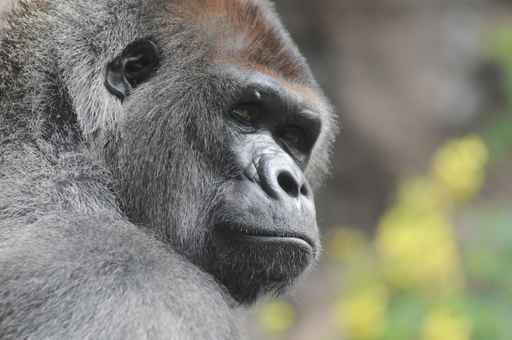A New Frontier in Animal Intelligence
Evidence that some animals are capable of “mental time travel,” suggests they have a deeper understanding of the world around them
Santino was a misanthrope with a habit of pelting tourists with rocks. As his reputation for mischief grew, he had to devise increasingly clever ways to ambush his wary victims. Santino learned to stash his rocks just out of sight and casually stand just a few feet from them in order to throw off suspicion. At the very moment that passersby were fooled into thinking that he meant them no harm, he grabbed his hidden projectiles and launched his attack.
Santino was displaying an ability to learn from his past experiences and plan for future scenarios. This has long been a hallmark of human intelligence. But a recently published review paper by the psychologist Thomas Zentall from the University of Kentucky argues that this complex ability should no longer be considered unique to humans.
Santino, you see, is not human. He’s a chimpanzee at Furuvik Zoo in Sweden. His crafty stone-throwing escapades have made him a global celebrity, and also caught the attention of researchers studying how animals, much like humans, might be able to plan their behavior.
Santino is one of a handful of animals that scientists believe are showing a complex cognitive ability called episodic memory. Episodic memory is the ability to recall past events that one has the sense of having personally experienced. Unlike semantic memory, which involves recalling simple facts like “bee stings hurt,” episodic memory involves putting yourself at the heart of the memory; like remembering the time you swatted at a bee with a rolled up newspaper and it got angry and stung your hand.
If an animal can imagine itself interacting with the world in the past via episodic memory – like Santino recalling a failed attack when a human spotted him holding a rock, or you remembering swatting at a bee – it stands to reason that the animal might also be able to imagine itself in the future in a similar scenario, and thus plan its behavior. Santino might opt to hide his rocks, and you might decide to stop antagonizing bees. The ability to represent oneself and one’s actions in the mind’s eye – both in the past in in the future – is what scientists refer to as mental time travel.
Mental time travel is a vital skill in the arsenal of human intelligence. When it goes right, we can devise and execute complex hunting strategies that allow us to herd woolly mammoths into a canyon for easy slaughter– something our ancestors excelled at in the late Pleistocene. When it goes really right, we can spend years devising and executing a plan to rocket astronauts through the coldness of space and land them safely on the moon. If it turns out that other species might have even the smallest hint of this ability, it raises the question of just how much we might be underestimating their ability to interact with, and understand, the world around them.
Zentall argues that mental time travel based on episodic memory has been observed in a number of species, including non-human primates like Santino, as well as dolphins, scrub-jays, rats, and pigeons. Scrub-jays in particular seem skilled at planning their food hiding (caching) behavior. In experimental conditions, they learned to cache food in areas where they knew they’d be hungry the following day, and made sure that their favorite food was cached in such a way that they’d always have access to it in the future.
But there is longstanding opposition to the idea of suggesting that animals are capable of mental time travel. The University of Queensland psychologist Thomas Suddendorf argues that despite “ingenious attempts to demonstrate episodic memory or future simulation in non-human animals,” it still seems that “there are few signs that animals act with the flexible foresight that is so characteristic of humans.” While animals like scrub-jays might be able to adapt their behavior to make the most of their food-caching, they do not display similar flexibility outside of this narrow domain. Unlike scrub-jays, “humans,” states Suddendorf, “can simulate virtually any event and evaluate it in terms of likelihood and desirability”
Zentall, however, has recently acquired a high-profile ally in Michael Corballis, a psychologist at the University of Auckland who once famously argued alongside Suddendorf that episodic memory was unique to humans. It was Suddendorf and Corballis who together coined the phrase mental time travel in 1997, and established a set of criteria that, if satisfied, could prove its existence in animals. By the age of 4, human children satisfy these criteria via their ability to choose the correct key to open a box that they’d never seen before based only on experience with similar boxes and keys in different locations in the past. Animals are typically only able to devise a similar solution after repeated exposure to the same test materials in the same setting, which means they might be solving problems via associative learning as opposed to mental time travel.
Corballis revealed earlier this year that new evidence has come to light that obliged him to change his mind as to whether these criteria had been met in animals. The evidence that tipped the scale for Corballis, however, was not found by observing animals’ behavior, but by measuring their brains. “Mental time travel has neurophysiological underpinnings that go far back in evolution, and may not be, as some (including myself) have claimed, unique to humans,” writes Corballis.
Recently published research shows how brain activity in rats suggest that they might be envisioning solutions to problems in their mind’s eye – in this case, an eye located in their hippocampus. After the rats ran a series of mazes during the day, researchers measured neuronal activity as they slept, concentrating on the hippocampus – the part of the brain where the mental map of the maze was stored. The rats appeared to not only be replaying their past experiences running through the maze in their sleep, but also replaying the parts of the maze that they had only considered running, but not actually run. For Corballis, this is neurological evidence of mental time travel at work.
And yet, some behavioral evidence seems like convincing evidence of mental time travel in animals, regardless of underlying brain activity. In one experiment, Bonobos and orangutans practiced using tools to retrieve food rewards – like a juice bottle hanging on a string that was only reachable with a hook. Knowing that they’d likely face a similar test situation the next day, the apes took the appropriate tool with them to their sleeping quarters and used it to retrieve their reward the next morning.
These skills do not seem a far cry from those employed by early humans to plan out the next day’s mammoth hunting excursion. Why then do we not see more examples of animals engaging in behaviors that unequivocally show the ability for mental time travel?
There’s more to the human intellect and ability to pull off successful mammoth hunts and moon landings than episodic memory of course, and other intellectual feats – not the least of which is our ability to convey our thoughts and plans via language – appear absent in non-human animals. There is also the question of how humans’ complex understanding of our own and others’ minds might be involved. Mental time travel likely requires some form of consciousness or self-knowledge to allow an animal to place itself at the heart of its memories and future plans, and much of this debate focuses on whether animals’ observed behavior or neurological activity are evidence of consciousness at work. Consciousness is the unknowable singularity at the heart of the black box.
Zentall is confident that future research will provide evidence that animals have skills like mental time travel that far exceed what we now attribute to them. He is surely correct. But as we slowly pry open the lid on the black box of animal minds, scientists will continue to disagree as to what shapes they see emerging from the darkness.
Autor: Justin Gregg





